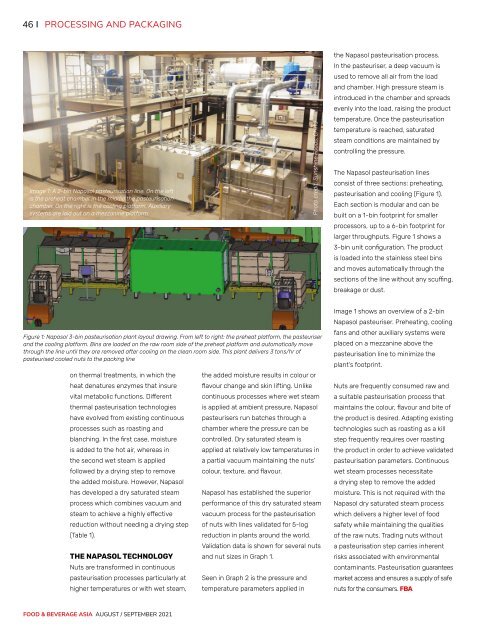Food & Beverage Asia August/September 2021
Food & Beverage Asia (FBA) is the leading source of food and beverage news in Asia since 2002. FBA delivers a comprehensive view of the food and beverage landscape, spanning across the latest health and nutrition trends and industry innovations in ingredients, recipe formulations, food science, sustainability, packaging, and automation, as well as advancements in agri and food-tech.
Food & Beverage Asia (FBA) is the leading source of food and beverage news in Asia since 2002. FBA delivers a comprehensive view of the food and beverage landscape, spanning across the latest health and nutrition trends and industry innovations in ingredients, recipe formulations, food science, sustainability, packaging, and automation, as well as advancements in agri and food-tech.
Create successful ePaper yourself
Turn your PDF publications into a flip-book with our unique Google optimized e-Paper software.
46<br />
PROCESSING AND PACKAGING<br />
Image 1: A 2-bin Napasol pasteurisation line. On the left<br />
is the preheat chamber in the middle the pasteurisation<br />
chamber. On the right is the cooling platform. Auxiliary<br />
systems are laid out on a mezzanine platform.<br />
Photo credit: Sunshine <strong>Food</strong>s, China<br />
the Napasol pasteurisation process.<br />
In the pasteuriser, a deep vacuum is<br />
used to remove all air from the load<br />
and chamber. High pressure steam is<br />
introduced in the chamber and spreads<br />
evenly into the load, raising the product<br />
temperature. Once the pasteurisation<br />
temperature is reached, saturated<br />
steam conditions are maintained by<br />
controlling the pressure.<br />
The Napasol pasteurisation lines<br />
consist of three sections: preheating,<br />
pasteurisation and cooling (Figure 1).<br />
Each section is modular and can be<br />
built on a 1-bin footprint for smaller<br />
processors, up to a 6-bin footprint for<br />
larger throughputs. Figure 1 shows a<br />
3-bin unit configuration. The product<br />
is loaded into the stainless steel bins<br />
and moves automatically through the<br />
sections of the line without any scuffing,<br />
breakage or dust.<br />
Figure 1: Napasol 3-bin pasteurisation plant layout drawing. From left to right: the preheat platform, the pasteuriser<br />
and the cooling platform. Bins are loaded on the raw room side of the preheat platform and automatically move<br />
through the line until they are removed after cooling on the clean room side. This plant delivers 3 tons/hr of<br />
pasteurised cooled nuts to the packing line<br />
on thermal treatments, in which the<br />
heat denatures enzymes that insure<br />
vital metabolic functions. Different<br />
thermal pasteurisation technologies<br />
have evolved from existing continuous<br />
processes such as roasting and<br />
blanching. In the first case, moisture<br />
is added to the hot air, whereas in<br />
the second wet steam is applied<br />
followed by a drying step to remove<br />
the added moisture. However, Napasol<br />
has developed a dry saturated steam<br />
process which combines vacuum and<br />
steam to achieve a highly effective<br />
reduction without needing a drying step<br />
(Table 1).<br />
THE NAPASOL TECHNOLOGY<br />
Nuts are transformed in continuous<br />
pasteurisation processes particularly at<br />
higher temperatures or with wet steam,<br />
the added moisture results in colour or<br />
flavour change and skin lifting. Unlike<br />
continuous processes where wet steam<br />
is applied at ambient pressure, Napasol<br />
pasteurisers run batches through a<br />
chamber where the pressure can be<br />
controlled. Dry saturated steam is<br />
applied at relatively low temperatures in<br />
a partial vacuum maintaining the nuts‘<br />
colour, texture, and flavour.<br />
Napasol has established the superior<br />
performance of this dry saturated steam<br />
vacuum process for the pasteurisation<br />
of nuts with lines validated for 5-log<br />
reduction in plants around the world.<br />
Validation data is shown for several nuts<br />
and nut sizes in Graph 1.<br />
Seen in Graph 2 is the pressure and<br />
temperature parameters applied in<br />
Image 1 shows an overview of a 2-bin<br />
Napasol pasteuriser. Preheating, cooling<br />
fans and other auxiliary systems were<br />
placed on a mezzanine above the<br />
pasteurisation line to minimize the<br />
plant‘s footprint.<br />
Nuts are frequently consumed raw and<br />
a suitable pasteurisation process that<br />
maintains the colour, flavour and bite of<br />
the product is desired. Adapting existing<br />
technologies such as roasting as a kill<br />
step frequently requires over roasting<br />
the product in order to achieve validated<br />
pasteurisation parameters. Continuous<br />
wet steam processes necessitate<br />
a drying step to remove the added<br />
moisture. This is not required with the<br />
Napasol dry saturated steam process<br />
which delivers a higher level of food<br />
safety while maintaining the qualities<br />
of the raw nuts. Trading nuts without<br />
a pasteurisation step carries inherent<br />
risks associated with environmental<br />
contaminants. Pasteurisation guarantees<br />
market access and ensures a supply of safe<br />
nuts for the consumers. FBA<br />
FOOD & BEVERAGE ASIA AUGUST / SEPTEMBER <strong>2021</strong>


















